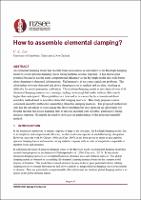| dc.contributor.author | Lee, Chin-Long | |
| dc.date.accessioned | 2023-08-28T04:23:24Z | |
| dc.date.available | 2023-08-28T04:23:24Z | |
| dc.date.issued | 2023-04-19 | |
| dc.identifier.uri | https://repo.nzsee.org.nz/xmlui/handle/nzsee/2569 | |
| dc.description.abstract | An elemental damping model has recently been proposed as an alternative to the Rayleigh damping model to avoid spurious damping forces during inelastic seismic response. It has shown great potential because it has the same computational efficiency as the Rayleigh model and could better relate damping to elemental deformations. Unfortunately, it has some significant problems. The relationship between elemental and global damping ratios is implicit and peculiar, resulting in difficulty for model parameter calibration. The resultant damping matrix is not classical even if all elemental damping matrices are, causing coupling between global modes with an effect much higher than anticipated. These problems are believed to be caused by the conventional direct assembly method used to assemble elemental damping matrices. This study proposes a more consistent assembly method for assembling elemental damping matrices. The proposed method not only has the advantage of overcoming the above problems but also opens up an opportunity for broader theories that relate damping ratio to internal material state variables, particularly during inelastic response. Examples are used to showcase the performance of the proposed assembly method. | |
| dc.language.iso | en | |
| dc.publisher | New Zealand Society for Earthquake Engineering | |
| dc.relation.ispartofseries | 2023;37 | |
| dc.subject | Advancements in research and practice in seismic performance | |
| dc.title | How to assemble elemental damping? | |
| dc.type | Article | |

